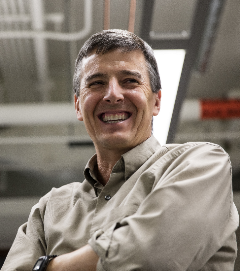John A. Rogers is the recipient of the 2021 Monie A. Ferst Award
Rogers is on the faculty at Northwestern University, where he is the Louis Simpson and Kimberly Querrey Professor of Materials Science and Engineering, Biomedical Engineering and Neurological Surgery, with affiliate appointments in Mechanical Engineering, Electrical and Computer Engineering and Chemistry. He obtained BA and BS degrees in chemistry and in physics from the University of Texas, Austin, in 1989. From MIT, he received SM degrees in physics and in chemistry in 1992 and the PhD degree in physical chemistry in 1995, under the mentorhip of Prof. K.A. Nelson in research on ultrafast laser systems and spectroscopic methods. From 1995 to 1997, Rogers was a Junior Fellow in the Harvard University Society of Fellows, working with Prof. G.M. Whitesides on materials and methods in soft lithography and with engineers at a startup company that he co-founded based on his PhD research, Active Impulse Systems (AIS). He joined Bell Laboratories as a Member of Technical Staff in the Condensed Matter Physics Research Department in 1997, and served as Director of this department from the end of 2000 to 2002. During this time, he pursued various projects in plastic electronics, fiber optics and precision laser metrology techniques. He then spent thirteen years on the faculty at the University of Illinois in Urbana/Champaign, most recently as the Swanlund Chair Professor, the highest chaired position at the university, and as the Director of the Seitz Materials Research Laboratory. In 2016, he moved to Northwestern to become the Director of the recently endowed Querrey/Simpson Institute for Bioelectronics. His interests are in unusual materials and fabrication techniques for broad classes of microsystems technologies, with an emphasis on bio-inspired and bio-integrated devices, across applications that range from maternal, fetal and neonatal health to neuroscience research.
Rogers has published nearly 800 papers, he is a co-inventor on more than 100 patents and he has co-founded several successful technology companies, including AIS (acquired by Philips Electronics), MC10 (acquired by Medidata), Epicore Biosystems (partnerships with Gatorade), Neurolux, Sibel Health (partnerships with Drager and the Gates Foundation) and Sonica (parternships with the Michael J. Fox Foundation). His research has been recognized by many awards, including a MacArthur Fellowship (2009), the Lemelson-MIT Prize (2011), the Smithsonian Award for American Ingenuity in the Physical Sciences (2013), the Benjamin Franklin Medal (2019) and the Guggenheim Fellowship (2021). He is a member of the National Academy of Engineering, the National Academy of Sciences, the National Academy of Medicine, the National Academy of Inventors and the American Academy of Arts and Sciences. He holds Honorary Professorships at Fudan University, Xi’an Jiaotong University and Zhejiang University, an Honoris Causa Doctorate from the École Polytechnique Fédérale de Lausanne (EPFL) and Doctor of Humane Letters, honoris causa, from the University of Houston.
His most significant career achievements, however, are in engaging students and postdocs in basic and applied research. Nearly 200 graduate students and postdoctoral fellows -- spanning biomedical engineering, materials science, physics, chemistry, mechanical engineering and electrical engineering -- have successfully passed through his group over the last twenty years. All but two are currently pursuing careers in science and/or technology; more than 100 are in faculty positions at leading research universities around the world, including MIT (female), Stanford, Duke (female), Dartmouth, Northwestern, Princeton (female), Cornell, Georgia Tech and the University of Illinois here in the US, Seoul National University, KAIST and Yonsei University in Korea, University of Heidelberg (female) and TU Delft (female) in Europe, and Tsinghua University (female) and Peking University in China, along with many others. Throughout his time as a faculty member, Rogers has also encouraged undergraduate involvement in research, typically hosting between 20 and 40 undergraduates per year in his laboratory, for a cumulative total of more than 250, a majority of whom co-authored papers as part of their experience. His current group consists more than 75 students (undergraduate and graduate) and postdoctoral fellows; more than half are women, well above the national percentages for physical sciences and engineering.
Rogers' published articles in American Scientist magazine:
Making the Cut
Tiny Lenses See the Big Picture